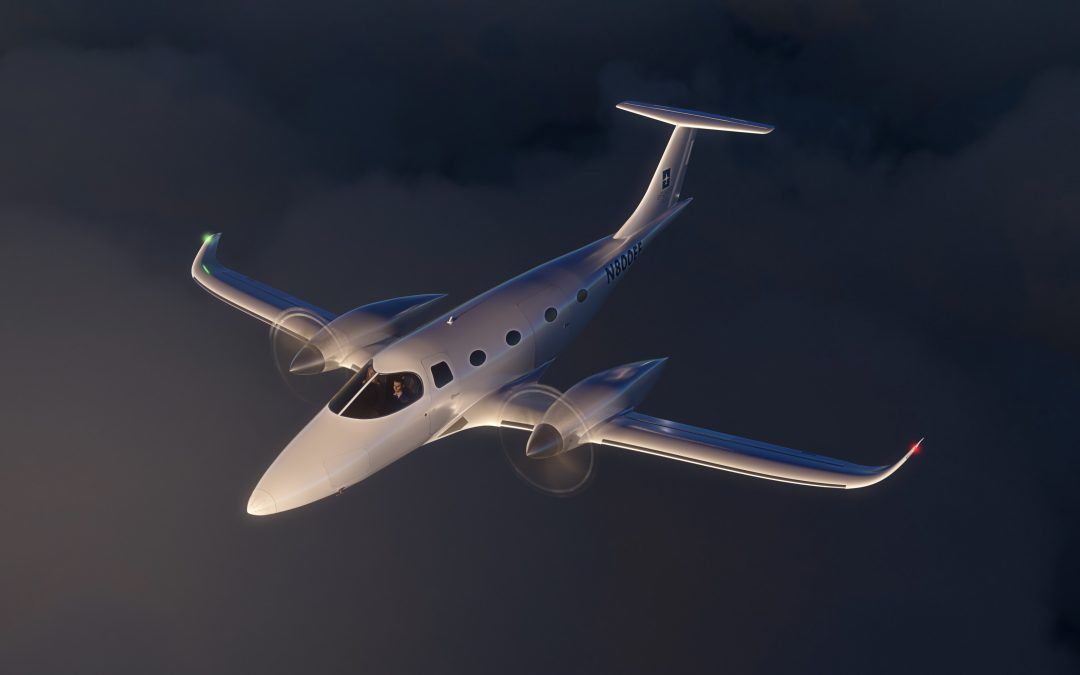A European air taxi operator has put a deposit down on future orders of Bye Aerospace’s eFlyer 800 to serve its short-hop scheduled service and on-demand flights. The King Air-sized twin is still on the drawing board and the FAA is still developing the regulatory structure for certification of electric aircraft, but both companies see a major role for this kind of aircraft in short-haul operations. “Air2E’s mission is to accelerate the transition to sustainable aviation and now with the eFlyer 800 we are another step closer to this aim.” Air2E CEO Norbert Werle said in a news release. “We intend to build an eFlyer 800 fleet for our AirTaxi service, which is already today the most economical individual flight solutions available.
The eFlyer 800 program was announced earlier this year and predicts a 320-knot maximum cruise speed, 35,000-foot ceiling and a 500 nautical mile range with IFR reserves at its normal cruise of about 280 knots. It will seat seven passengers and one or two pilots. Bye is claiming operating costs of 20 percent those of comparably sized turboprops.




































A bit surprising that the projected cost savings is only 20%. I would have thought the cost of fuel and the elimination of turbine overhaul costs would have yielded better savings.
“Bye is claiming operating costs of 20 percent those of comparably sized turboprops”
20% of the cost of a turboprop.
Projected cost savings is 80% relative to a turboprop. The article says, ‘claiming operating costs of 20 percent those of comparably sized turboprops’, not ‘…20 percent less than those…’.
Copy Editor: perhaps it would have been clearer to add the word ‘of’, to read ‘…20 percent of those…’.
Read it again, it says the operating costs will be 20% of those for similar (King Air) conventional aircraft. However the article is as if they are ready to go, just place the order and start taking delivery. The specs are fantastic fantasy and will require more than one quantum leap in power storage.
Read it again. The article notes the FAA is still writing the rules.
PT Barnum wins again!
Perhaps we should start a “futures market” on these “developing” (or better yet, “undeveloped”( airplanes.
We could place or “cover” bets on whether they actually get certified and built.
Better yet, move them to a separate “Press release” section–people can go there and dream, and the rest of us won’t have to wade through breathless promises.
The futures market would be a REALLY good idea.
As for having to wade through stories, it’s tough not to click isn’t it?
Mr. Bye isn’t even delivering his two seat trainers and he’s now accepting orders for a King Air sized machine!! Powered by what … fairy dust? I guess he hasn’t heard that airplanes have to expend energy to defeat gravity over and above motive force to move forward ?
Oh well, I just heard Governator Newsome is gonna ban gas powered lawn mowers in Kalyfornya. This craziness is nothing more than vaporware designed to separate fools from their money … as William already said, above.
Not just lawn mowers, all forms of small, off-road, gas engines – including generators!
I lived in Kalyfornya for 30 years. In 1970, I thought I’d found the pot of gold at the end of the rainbow. Thirty years later in 1999, happiness was the place in my rear view mirror eastbound across the Colorado River on I-10. I wouldn’t give ya thirty cents for the whole place now. Evidently, Elon feels the same way … I hear he’s relocating his Tesla HQ to Austin.
Yep, Musk is moving the company HQ to the Austin area. He already has a large manufacturing site in central Texas as well as the SpaceX operations down in south Texas.
There are many brands of corded and battery powered mowers on the market. I’m not a fan of bans, including this one, but the tech is not “fairy dust”.
Turbine engines do a lot more than just propel a King Air. They also provide the air for cabin pressurization and for de-ice boots, among other fringe benefits. Electric airplanes struggle with energy capacity to simply conduct the flight. I wonder if they have really counted in all of the extra power needs for operating at high altitude and in real, commercial IFR weather.